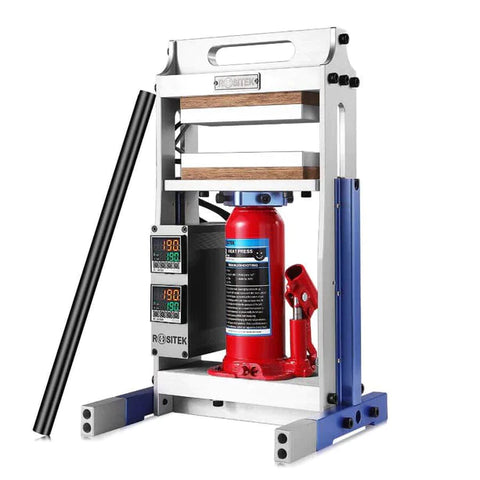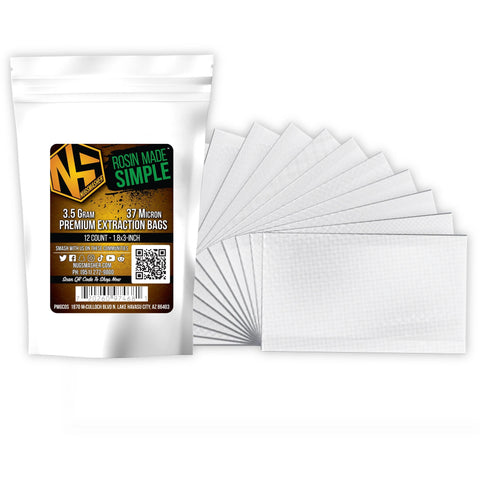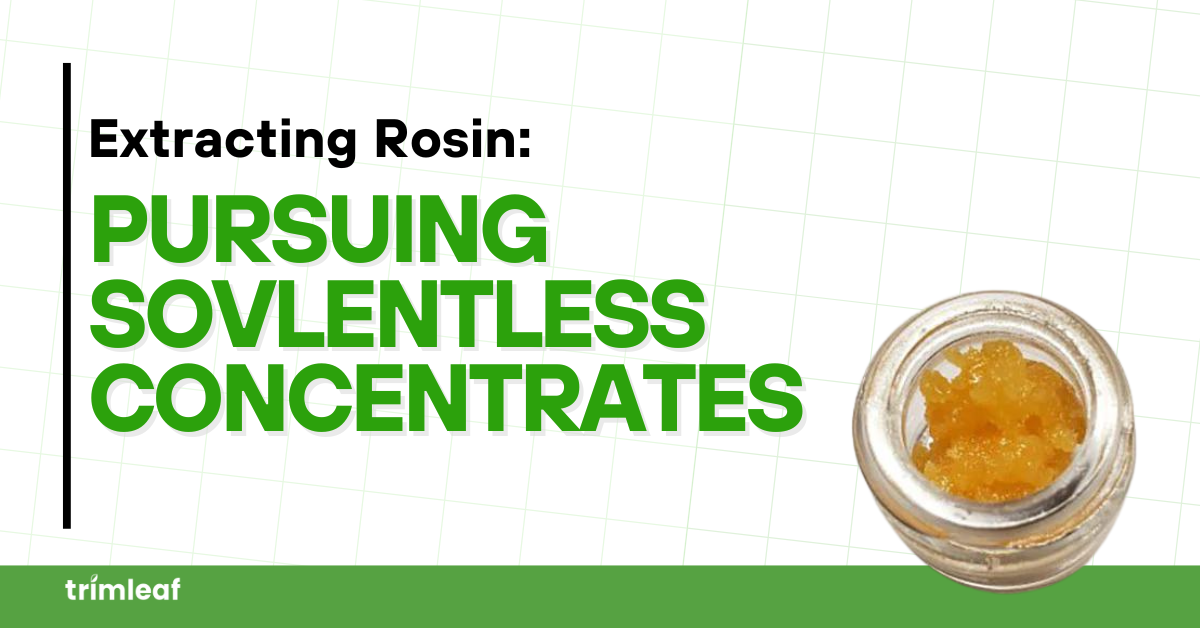
Rosin has become the standard of pure cannabis concentrates due to its solventless extraction technique. This is a landmark of purity and a statement of authenticity where quality is paramount.
Whether you're exploring the therapeutic benefits of cannabis or are a connoisseur of its many forms, getting into rosin offers an experience that puts purity and potency together.
Unlike other cannabis concentrates that rely on chemicals for extraction, rosin is obtained through a simple yet effective heat and pressure process. This comprehensive guide will help you understand rosin and why many cannabis consumers like this extract.
Table of Contents
- What is Rosin?
- What's the Difference Between Solventless and Solvent-Free?
- What Makes Rosin Popular?
- 5 Types of Cannabis Rosin
- Checking If the Rosin is of High Quality
- Extracting Rosin Using a Rosin Press
- How Pressure and Time Influence Your Yields
- 4 Techniques for Precise and Refined Rosin Extraction
- Tools of the Trade: Parchment Paper & Rosin Bags
- Understanding Micron Ratings
- Importance of Choosing the Micron Rating
- How Much Can You Get?
- What Strains are Best for Extracting Rosin?
- Tips for Pressing the Best Rosin
- Conclusion
- Frequently Asked Questions About Rosin
What is Rosin?
Rosin is a type of cannabis concentrate extracted by applying heat and pressure. The process is simple: cannabis plant material is placed between heated plates in a press. When compressed with heat, an amber oil is secreted. Rosin's solventless nature makes it different, meaning no chemicals or solvents are used in deriving it, making it a purer choice than other concentrates.

Rosin is popular because of its flavor profile, compared to other cannabis concentrates. This is due to the need for solvents or chemicals in the processing. You get a cleaner and pure taste, allowing you to taste the terpenes easily.
Rosin can be extracted from various types of cannabis material, such as buds, trim, kief, and hash. The quality of rosin depends a lot on the quality of the plant material.
To get you started, you can get a flavorful dab experience with buds, considered high-quality starting materials. Using excess trim, kief, or hash. However, the results might differ when pressing buds.
What's the Difference Between Solventless and Solvent-Free?
When selecting cannabis concentrates, it's important to know how they are made.

Solvent-Free (Live Resin)
Solven-free resin uses a chemical solvent, like butane or CO2, to separate the good stuff from the plant material—cannabinoids, terpenes, and other valuable compounds.
After extraction, the solvent is purged meticulously, leaving behind a clean, concentrated dose of pure cannabis goodness.
Solventless (Rosin)
Solventless concentrates focus on purity by applying pressure and heat to the plant material. It's like squeezing oranges to get the good stuff out without using any chemicals.
This method extracts trichomes mechanically, which are packed with cannabinoids and terpenes. Some common examples are ice water hash and dry-sift hash, which are loved for their natural and flavorful taste.
So, which is better - rosin or resin?
While both are popular options and highly potent forms of top-shelf concentrate, many consumers prefer rosin to avoid risks of exposure to residual solvents. While rosin is better for you, the complicated process makes it more expensive.
What Makes Rosin Popular?
‣ Ease of Production - One reason why rosin appeals to many is the ease of producing it. It only takes a few minutes to get the potent extract without worrying about purifying or diluting it. The process is simple, as this can be done with a few tools you may have at home.
‣ Potency - The potency of rosin varies, depending on the source plant material. But, to gauge things, rosin sits somewhere between buds and shatter. But it all boils down to the plant material.
‣ Versatility - In terms of consumption, rosin is versatile. You can load it to a dab rig and experience its potency in a controlled manner. Besides dabbing, rosin can also be filled into cartridges and vaped, providing a solvent-free alternative to other vape products that contain traces of solvents like butane.
5 Types of Cannabis Rosin
Now, there are three types of rosin available:.
1. Flower Rosin - Flower rosin uses dried buds, shakes, or trim suitable for its flavor profile. It's the go-to choose for those who prefers authentic and solventless cannabis.
2. Hash Rosin - Hash rosin comes from bubble or dry sift hash. It may taste harsher than flower rosin, but it is also known for having a more robust potency.
3. Live Rosin - Live rosin is derived from frozen cannabis buds, which helps preserve terpenes, making it more flavorful than other rosin variants.
4. Solventless Rosin Sauce - This rosin focuses on terpenes. Rosin sauce is made by heating and applying pressure to pure rosin until it turns into a jam-like substance.
5. Rosin Distillates - If you want a strong and versatile form of cannabis that's pure and potent, then this is perfect for you. Rosin distillates are made by refining rosin even more through a process called distillation.
Checking If the Rosin is of High Quality

Extracting Rosin Using a Rosin Press
Extracting rosin requires a rosin press to apply heat and pressure to the plant material.
Different types of rosin press come with their benefits and considerations. If you're having difficulties in choosing which rosin press to buy, consider what is best for you depends on the amount of plant material to press, size, and budget.
Here are the different types of rosin presses:
- Manual Rosin Presses: These are the most budget-friendly options. Manual operation requires you to use your hands to apply and hold pressure. An excellent example of this is the Ju1cebox.
- Hydraulic Rosin Presses: While it uses manual operation, hydraulic rosin presses use a hydraulic system for pressing. They can be operated by a hand, foot, or electric pump to extract rosin.
- Pneumatic Rosin Presses: They use compressed air to apply pressure. While they are more expensive than other rosin presses, they are efficient for extracting from large quantities of plant material.
- Electric Rosin Presses: The most compact and user-friendly rosin press relies on electric power.
How Pressure and Time Influence Your Yields
Achieving the perfect rosin extraction involves a delicate balance of pressure and time when pressing. Understanding how these factors interact can significantly affect the quality and yield of your final product.
Finding the Right Pressure Setting
Time and Temperature Tradeoff
Fine-Tuning the Process
4 Techniques for Precise and Refined Rosin Extraction

1. Use a Timer - Use a timer or the timer function on your rosin press to ensure precise results to maintain accurate and repeatable press times. Consistency in timing is crucial for developing a reliable extraction process.
2. Utilize Pressure Sensors - If your rosin press comes equipped with pressure sensors, take advantage of this feature to monitor and record the pressure applied during each extraction, allowing you to fine-tune your process for different strains.
3. Document Extraction Sessions - To help you improve your extraction techniques, document your extraction sessions, noting the strain, starting material, pressure, and pressing time to achieve consistent results overtime.
4. Pay Attention to the Quality and Yield - Use the information you gather to make informed adjustments, ultimately enhancing your ability to produce high-quality rosin.
Tools of the Trade: Parchment Paper & Rosin Bags
Parchment paper serves as the surface where your rosin flows during extraction. Not missing this part is essential, as substituting it can lead to disastrous results.
There are also folding techniques for the parchment paper. There’s a fold called directional fold, which is recommended to ensure clean and consistent extract. To make this fold:
- Put your kief or hash in the centerpiece of the parchment paper.
- Fold the parchment paper around the plant material, like an envelope, and leave one side open.
- Keep the three sides open to ensure the flow of rosin to the open side for easy collecting.
For buds, this folding technique is not necessary. You can fold the paper over the buds.
Likewise, using a proper rosin bag to match the plant material you’re extracting from would be best. You want higher micron ratings when extracting from materials like bubble hash.
Lower micron ratings work for buds. Note that you should not overload the rosin bag as this can lead to blowouts, compromising the quality of any good plant material.
Understanding Micron Ratings
Micron ratings refer to the size of the openings in a rosin bag's mesh, determining the size of particles that can pass through during the extraction process. Measured in micrometers, a lower micron rating indicates a finer mesh with smaller openings.
Choosing the Right Micron Rating:
-
For Bubble Hash or Kief:
- Use rosin bags with a micron rating of 25 – 90.
- This range prevents unwanted contaminants from passing through.
- It allows the extraction of essential cannabinoids and terpenes.
-
For Buds and Trim:
- Use rosin bags with a micron rating of 90 and above.
- This range allows optimal flow of rosin.
- It retains larger particles that could compromise extract quality.
When working with live rosin, derived from frozen cannabis buds, the preservation of terpenes is a priority. Opt for lower micron bags to capture the delicate terpenes while still allowing cannabinoids to pass through, resulting in a more flavorful and aromatic live rosin.
Importance of Choosing the Micron Rating

‣ Extracted Rosin Color - Micron ratings can influence the color of the extracted rosin. Finer materials, extracted with lower micron bags, may produce a lighter-colored rosin.
‣ Overloading - Overloading a rosin bag with too much material can lead to blowouts, where the bag bursts during the extraction process. This can negatively impact the quality of the extract.
‣ Achieving Quality Results - Consistency in micron rating is essential for achieving consistent results. Using different micron ratings and documenting the outcomes can help you fine-tune the process for various strains and materials.
How Much Can You Get?
Extracting rosin is also a matter of quantity and potency. Factors that can affect the quantity you get include the strain, starting material, and equipment used in extracting.
- Buds and Trim: Pressing dried buds or trim can get your around 15 - 30 percent yield, although higher quality buds can produce slightly more.
- Kief and Hash: Rosin extracted from kief and hash can produce a slightly higher yield, ranging from 20 - 30 percent, due to its finer and purer form, compared to buds and trims.
- Live Rosin: Pressing live rosin produces a lower yield due to its terpene preservation, and the fact that it is a fresh starting material. While you can get yields of around 10 – 20 percent, it does come with a better flavor and aroma.
Note that these are just estimates of possible yields. The settings and technique used in pressing can play a factor in the outcome.
What Strains are Best for Extracting Rosin?
The strain you choose for rosin plays a vital role in the quality of rosin you get. Some strains boast qualities that make them stand out in extraction due to their trichome structure, terpene profiles, or the consistent yield quantities you get.
- Gorilla Glue #4 (GG4) - The GG4 is known for its high trichome density, potent THC content that can go as high as 30 percent, and terpene profile, which results in a high and flavorful yield.

Photo courtesy of leafly.com
- Chem Dawg - This strain is known for its blend of terpene and THC, which gives it a pine, earthy, and sour flavor, which is suitable for anyone who values quality flavors.
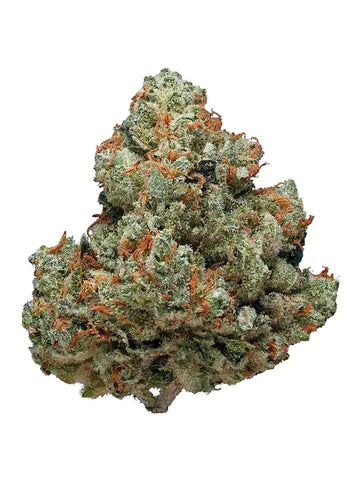
Photo courtesy of hytiva.com
- Strawberry Banana - This strain is regarded for its potency and rich terpene profile, giving sweet and fruity aromas with tropical flavor undertones. You can get as much as 22 percent yield, which is a good mix of quality and quantity.
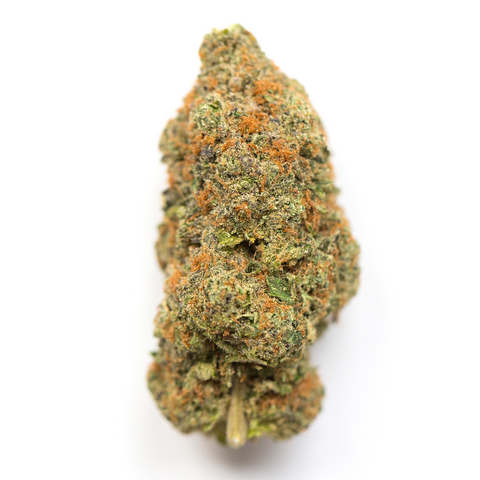
Photo courtesy of leafly.com
Tips for Pressing the Best Rosin
- Use high-quality, properly cured flower. The quality of your starting material greatly influences the quality and yield of your rosin.
- Dry sift or bubble hash can yield more and higher quality rosin compared to flower.
- If using flower, ensure it's properly hydrated. A moisture content around 55-62% RH (relative humidity) is ideal for pressing.
- Pre-press your material into a compact shape with a pre-press mold or by hand to increase yield and maintain consistency.
- Lower temperatures (180-220°F) for a longer time (60-120 seconds) produce a more flavorful, terpene-rich rosin but may yield less.
- Higher temperatures (220-250°F) for a shorter time (45-60 seconds) increase yield but can sacrifice some flavor and quality.
- Allow the rosin to cool on the parchment paper before collecting to make it easier to handle.
- Use a cold tool (put your collection tool in the freezer for a bit) to help prevent the rosin from sticking to it.
Conclusion
Rosin emerges as a potent way of consuming cannabis with its benefits. Granted that there are many factors to consider, understanding what makes good rosin will allow you to make the best choice for consumption. Understanding what rosin is will allow you to maximize its potential.
Looking for more insights? Here are some good reads:
- Rosin Pressing Techniques: How to Make Rosin Like a Pro
- What Is Live Rosin And How To Make Live Rosin
- How To Make Dabs Using Rosin
- Best Rosin Presses to Buy (2024)
Frequently Asked Questions About Rosin
- How Do I Consume Rosin?
- The most common way to consume rosin is through dabbing. You vaporize a small amount of rosin on a heated nail using a dab rig. Rosin can also be added to vape pens designed for concentrates, or infused into edibles.
- What Temperature Should I Dab Rosin At?
- The ideal temperature for dabbing rosin depends on the specific rosin and your preferences. Lower temperatures (around 500°F) will preserve more flavor and terpenes, while higher temperatures (up to 600°F) will produce a larger vapor cloud.
- How Do I Store Rosin?
- Rosin should be stored in an airtight container in a cool, dark place. Parchment paper is a good option for storing rosin, as it helps prevent it from sticking. You can also store rosin in the fridge or freezer for longer-term storage.
- How Long Does Rosin Last?
- Properly stored rosin can last for several months. However, over time, rosin can degrade and lose potency and flavor.
- Can Rosin be Used Medically?
- Rosin may offer potential medical benefits similar to cannabis flower, but more research is needed. Consult with a healthcare professional before using rosin for medical purposes.
- What are the Safety Considerations When Using Rosin?
- Start with a low dose when consuming rosin, as it can be more potent than flower. Use proper dabbing equipment and avoid overheating the rosin.
- How Does Rosin Compare to Other Concentrates?
- Rosin offers a solventless alternative to concentrates like shatter or budder, which are produced using chemical solvents. Compared to other solventless concentrates like live resin, rosin generally has a simpler extraction process.
- How Much Rosin Can I Expect to Yield?
- The yield of rosin depends on the strain, starting material, and extraction process. Yields can range from 10% to 30%.
- What Strains Are Best for Rosin Extraction?
- Strains with high trichome density and desirable terpene profiles are good choices for rosin extraction. Some popular strains include Gorilla Glue #4, Chem Dawg, and Strawberry Banana.

